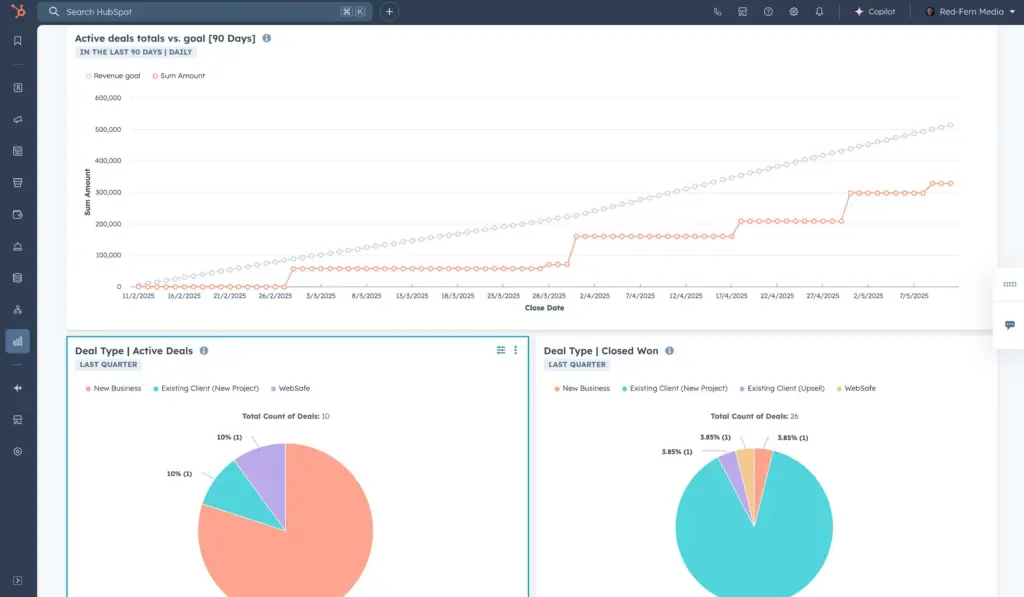Marketing is an investment to support sales teams.
In an ever challenging manufacturing sector, with changing trade tariffs, material costs and international trade pressures, Finance Directors often grapple with the challenge of understanding how the efforts and investments into sales and marketing in manufacturing translate into tangible financial outcomes, plus, most stakeholders in sales who are of a certain age still struggle to see the benefit of allocating budget to marketing. Misalignment between sales and marketing departments can lead to frustration, wasted resources, personal pressures and missed revenue opportunities.
This guide will highlight some of the top challenges Red-Fern come across when speaking with manufacturing companies across the world and provides actionable strategies for Finance Directors and sales teams, helping them gain a greater understanding to foster alignment between sales and marketing, ultimately enhancing lead generation and profitability.
No time to read this article, why not listen to the audio conversation.
1. Establish unified objectives
Challenge: Sales and marketing teams often operate with differing goals, leading to fragmented efforts.
Solution: As a Finance Director, facilitate the development of shared objectives that tie directly to financial metrics. Encourage both teams to focus on common KPIs such as Customer Acquisition Cost (CAC), Lifetime Value (LTV), and Return on Investment (ROI).
To drive this alignment, hold quarterly joint planning sessions that bring commercial strategy under one roof.
Example joint sales and marketing planning session
Attendees:
- Finance Director – Chairing the session, ensuring commercial accountability and financial alignment.
- Sales Director – Reporting on sales performance and future projections.
- Marketing Director – Presenting campaign results and upcoming initiatives.
- Business Development Manager – Providing insight into lead quality and conversion challenges.
- CRM/RevOps Lead – Sharing data on funnel metrics, pipeline health, and conversion rates.
Sample agenda (90 minutes):
Assign owners to each objective, document SLAs, set next meeting.
- Welcome and objective Setting (5 mins)
Finance Director outlines session goals and expected outcomes. - Review of last quarter’s KPIs (15 mins)
CAC, LTV, lead-to-close rates, revenue attribution, campaign spend vs. ROI. - Sales feedback loop (15 mins)
Sales Director and BDM share lead quality issues, objections, lost deals, and feedback on MQLs. - Marketing performance review (15 mins)
Marketing Director presents campaign performance, content reach, channel ROI, and lead generation. - Shared KPIs and commercial goal alignment (20 mins)
Define shared goals for the upcoming quarter (e.g., number of qualified leads, pipeline value, closed-won targets). - Collaborative campaign planning (15 mins)
Brainstorm and agree on priority campaigns that support key product lines or markets, with financial goals attached. - Next steps and accountability (5 mins)
2. Implement integrated reporting systems
Challenge: Disparate reporting tools hinder transparency and accountability.
Solution: Advocate for the adoption of integrated CRM and marketing automation platforms like HubSpot, which offer real-time, end-to-end visibility across the entire lead journey — from first website visit to closed-won deal.
Why HubSpot works for manufacturers
Manufacturing sales cycles are complex, with long buying journeys, multiple stakeholders, and a mix of digital and offline interactions. HubSpot gives Finance Directors and commercial leaders the visibility to track, attribute, and optimise every step of that journey — with zero data silos.
Five HubSpot features that align sales and marketing in manufacturing
Attribution reporting
- What it does: Shows exactly which marketing actions contributed to a lead becoming a customer.
- Why it matters: You’ll know if that whitepaper, email campaign, or LinkedIn ad actually led to a deal — not just a click.
- Finance Director value: Quantify marketing ROI at every touchpoint and justify spend based on real revenue impact.
Lead scoring and lifecycle stages
- What it does: Automatically scores leads based on behaviours (e.g. website visits, downloads) and demographics.
- Why it matters: Ensures only sales-ready leads are passed on — reducing time wasted on cold or unqualified contacts.
- Finance Director value: Drives up lead-to-close rates, cuts acquisition costs, and keeps your sales team laser-focused.
Sales and marketing dashboards
- What it does: Real-time dashboards display key metrics across both teams — from MQL volume to deal pipeline and close rate.
- Why it matters: Creates one version of the truth. No more finger-pointing between departments.
- Finance Director value: See the full funnel performance in one place and make data-backed budget decisions.
Campaign ROI tracking
- What it does: Ties every campaign back to influenced contacts, pipeline generated, and closed revenue.
- Why it matters: You’ll know which campaigns bring in money — and which just bring in traffic.
- Finance Director value: Reallocate spend to high-performing campaigns, cut deadweight channels, and optimise faster.
Sales and marketing playbooks
- What it does: Provides sales reps with structured guidance, call scripts, and marketing content directly in the CRM.
- Why it matters: Sales stays aligned with the messaging and value propositions marketing has built.
- Finance Director value: Consistency improves conversion. It also ensures sales effort aligns with the most profitable products or segments.

Red-Fern recommendation
As a HubSpot Platinum Agency we don’t just recommend HubSpot to manufacturers — we implement, train, and embed it across commercial teams. Every Red-Fern manufacturing client that has adopted HubSpot has:
- Improved attribution clarity
- Reduced CAC
- Aligned marketing output with profitable product lines
- Gained confidence in their lead pipeline
It’s not a tech stack expense. It’s a commercial performance engine.
3. Define clear lead qualification criteria
Challenge: Ambiguity in lead definitions results in low-quality leads being passed to sales.
Solution: Collaborate with sales and marketing to establish a standardised lead scoring system based on explicit (e.g., company size, industry) and implicit (e.g., engagement behaviour) criteria. This clarity ensures that only high-potential leads are pursued. Regularly review and adjust these criteria based on performance data.
The key here is not to put deals on the board that have no chance of converting. We’ve all done it, add a deal to the sales pipeline only to be disappointed a couple of months later because the deal did not convert, plus, from a sales perspective not getting this implemented correctly puts pressure on sales are the sales pipeline becomes inflated with unqualified financial values.
Example: Manufacturing lead scoring system
Let’s assume you’re a manufacturing company targeting mid-size OEMs in the UK. Here’s a simplified model using HubSpot’s built-in lead scoring tool.
Explicit (Fit-Based) Criteria — Max 50 Points
| Criteria | Score |
|---|---|
| Company Size: 50-500 employees | +10 |
| Industry: Industrial/OEM | +10 |
| Job Title: Ops/Engineering Lead | +10 |
| Located in the UK | +10 |
| Existing CRM Contact | +10 |
| Free email address (e.g. Gmail) | -10 |
Implicit (Engagement-Based) Criteria — Max 50 Points
| Behaviour | Score |
|---|---|
| Visited product/service page (3x+) | +15 |
| Downloaded buyer’s guide / whitepaper | +10 |
| Attended a webinar or demo | +10 |
| Opened and clicked 2+ marketing emails | +5 |
| Visited pricing or contact page | +10 |
Lead scoring thresholds
- 0–40 Points → Low-quality lead: nurture only
- 41–69 Points → Marketing Qualified Lead (MQL): continue nurturing, not sales-ready
- 70+ Points → Sales Qualified Lead (SQL): passed to sales with full activity history
4. Align budgeting with strategic goals
Challenge: Marketing budgets are often allocated without direct correlation to revenue targets.
Solution: As a Finance Director, you need to bring financial discipline into marketing planning. Integrate budget setting into your annual financial strategy, and allocate funds based on projected ROI — not assumptions or gut feel.
How to align marketing spend with lead and revenue goals
- Start with revenue targets
Example: You want £5M in new business from marketing-led leads this year. - Work backward from average deal value (ADV)
Let’s say your ADV is £50K. That means you need 100 new customers. - Use historical conversion rates
If your lead-to-customer rate is 5%, you’ll need 2,000 leads to hit your target. - Factor in cost-per-lead (CPL)
If your average CPL from paid campaigns is £125, that’s a budget of £250,000 needed to deliver 2,000 leads.
How to attribute paid marketing to conversion values
Here’s how to calculate ROI and justify every £1 spent:
Use UTM parameters + CRM integration
- Every ad click (Google, LinkedIn, Meta) should use UTM tags.
- HubSpot or Salesforce will track the lead source through the entire buyer journey.
Track first and last touch attribution
- First touch = the channel that created the contact
- Last touch = the final interaction before conversion
- HubSpot shows you both so you can assign revenue accordingly.
Use contact-to-customer attribution reports
ROI = £400K ÷ £10K = 40X return
For example:
- £10,000 spend on Google Ads
- 400 leads generated
- 8 customers closed
- £400K revenue generated
5. Foster cross-departmental collaboration
Challenge: Siloed departments impede the flow of information and cohesive strategy execution.
Solution: Encourage regular interdepartmental meetings and workshops to promote understanding and collaboration. Shared insights can lead to more effective campaigns and a unified approach to customer engagement. Consider implementing cross-functional teams for specific projects to enhance cooperation.

6. Monitor and adjust strategies based on data
Challenge: Static strategies fail to adapt to market changes and consumer behaviour.
Solution: As a Finance Director, you can drive accountability and agility by insisting on real-time performance analytics that give clear visibility into what’s working and what’s not — from campaign spend to lead quality to revenue contribution.
How to Implement Actionable Analytics in Manufacturing
Create a unified dashboard
Use platforms like HubSpot, Databox, or Looker Studio to build real-time dashboards combining marketing, sales, and financial data.
What to include:
| Metric | Why It Matters |
|---|---|
| Cost per Lead (CPL) | Tracks marketing efficiency per channel |
| Marketing Qualified Leads (MQLs) | Measures top-of-funnel performance |
| Sales Qualified Leads (SQLs) | Indicates how well marketing is targeting |
| Lead-to-Customer Rate | Shows full-funnel effectiveness |
| Pipeline Value by Source | Identifies high-value acquisition channels |
| Revenue per Campaign | Direct attribution to closed-won deals |
Set up weekly “Health Check” alerts
- Trigger alerts for key variances:
e.g., CPL rises by 20%, SQL volume drops, or email click-throughs fall below benchmark. - Finance Directors should receive these as automated summary emails or slack alerts, helping you spot problems early without digging into raw data.
Run monthly performance reviews
Facilitate structured reviews for sales and marketing in manufacturing leads to answer:
- What campaigns underperformed?
- Where are leads dropping off in the funnel?
- Are sales following up with MQLs within SLA?
- What’s the CAC vs. LTV per channel?
This builds a culture of agility — grounded in metrics.
When and how to pivot based on data
Examples:
- High engagement but low pipeline contribution from email
Look beyond opens and clicks — prioritise content that leads to demo bookings or RFQs. - Underperforming Google Ads Campaign
Drop keywords or audiences with high CPL and no conversions. Reallocate budget to high-performing campaigns. - High MQL volume but low SQL conversion
Leads aren’t sales-ready. Adjust targeting or content offer. Tighten lead scoring criteria.
7. Invest in training and development
Challenge: Teams may lack the necessary skills to adapt to integrated strategies.
Solution: As a Finance Director, support ongoing investment in practical, ROI-driven training that improves digital fluency, analytics skills, and CRM utilisation across both departments.
Training isn’t a cost — it’s a multiplier for your tech and people investment.
Recommended training resources for manufacturing teams
HubSpot academy (Free & Paid)
Best for: CRM training, inbound marketing, sales enablement
Certifications:
- Inbound Marketing
- Sales Enablement
- RevOps
- Reporting and Attribution
academy.hubspot.com
Red-Fern tip: We recommend every client’s marketing team complete the “Inbound Marketing” cert and sales team complete “Sales Enablement”, even if you do not use HubSpot, this education is free and engaging.
Google skill shop
Best for: PPC, Google Analytics, search & video advertising
Certifications:
- Google Ads Search
- Google Ads Measurement
- Google Analytics 4
skillshop.withgoogle.com
Value: Helps your teams understand how digital ads are performing — and how to use analytics to optimise campaigns.
LinkedIn Learning
Best for: Sales prospecting, CRM use, data literacy
Courses include:
- CRM Fundamentals
- Sales Strategy: From Plan to Execution
- Data-Driven Decision Making
linkedin.com/learning
Use it to: Give new sales hires a foundational CRM course or support cross-training across departments.
Coursera / edX (University-Led Courses)
Best for: Deeper learning in digital strategy, AI in marketing, and B2B strategy
Top courses:
- Digital Marketing Specialisation (University of Illinois)
- Business Analytics (Wharton / UPenn)
- AI for Everyone (Andrew Ng)
coursera.org | edx.org
Great for: Leadership-level learning and strategic digital understanding.
Red-Fern Custom Workshops
Best for: Manufacturer-specific sales and marketing alignment
Format: Onsite or remote training tailored to your ideal audience profile, tech stack, and revenue goals
Delivered by: Red-Fern specialists with manufacturing sector experience
8. Leverage customer feedback
Challenge: Ignoring customer insights can lead to misaligned messaging and offerings.
Solution: Implement feedback loops where customer insights are shared across departments to refine products, services, and communication strategies, ensuring they meet market demands. Use surveys, interviews, and analytics to gather actionable feedback.
9. Set up accountability structures
Challenge: Without clear accountability, it’s difficult to measure success and areas for improvement.
Solution: Define specific roles and responsibilities within sales and marketing teams, establishing accountability for lead generation targets and conversion rates. Implement performance reviews and incentive programs tied to these metrics.
Key Roles in Sales & Marketing — and What They’re Accountable For
Marketing Director / Head of Marketing
Responsibility:
- Oversee all campaigns that drive awareness and lead generation
- Set KPIs: MQL volume, lead quality (scoring), campaign ROI
- Align campaign focus with profitable products and commercial targets
Accountability:
- MQL target per quarter
- Cost per lead (CPL)
- Marketing-generated pipeline value
Digital Marketing Manager / Specialist
Responsibility:
- Execute campaigns: SEO, PPC, email, content, LinkedIn
- Optimise based on data and lead quality feedback
- Own analytics dashboards and report results weekly
Accountability:
- Lead quality score trends
- Channel-level CPL
- Landing page or ad conversion rates
Sales Director / Commercial Director
Responsibility:
- Manage sales team to convert MQLs into opportunities and revenue
- Align sales strategy with marketing campaigns and feedback loops
- Lead forecasting and CRM accuracy
Accountability:
- SQL acceptance rate
- Lead response time compliance (e.g., within 2 hours)
- Revenue closed from marketing-sourced leads
Business Development Manager (BDM)
Responsibility:
- First responder to MQLs — discovery calls, demos, qualification
- Input lead feedback into CRM and lead scoring model
- Handover high-fit leads to Account Executives
Accountability:
- MQL-to-SQL conversion rate
- Time-to-contact KPIs
- Feedback submission rate on unqualified leads
10. Utilise predictive analytics
Challenge: Inability to forecast trends leads to reactive rather than proactive strategies.
Solution: Employ predictive data analytics to anticipate market trends, customer behaviours, and potential challenges, allowing for strategic planning and resource allocation. AI tools like ChatGPT or Grok can provide advanced forecasting capabilities.


